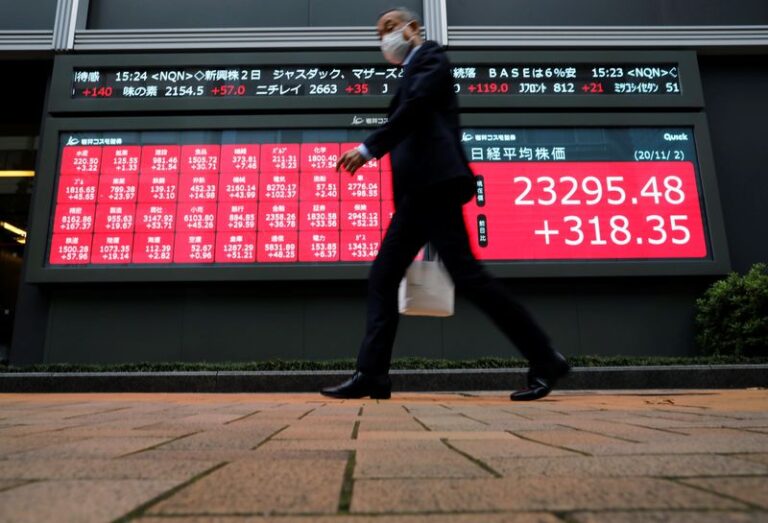
(Reuters) – Asian shares rose toward a more than two-year peak on Thursday, buoyed by sustained global stimulus efforts and hopes of a coronavirus vaccine, but some analysts warned of the risk of a correction lower.
MSCI’s broadest index of Asia-Pacific shares outside Japan .MIAPJ0000PUS rose 0.44%, approaching the highest since January 2018. Chinese shares .CSI300 rose 0.37%. Stocks in Japan .N225 rose 0.62% to a 29-year high.
Australian stocks .AXJO bucked the regional trend and fell 0.31% as a decline in copper prices hurt shares in miners. S&P 500 stock futures EScv1 fell 0.15%.
Oil futures rose toward two-month highs due to optimism about a vaccine and a larger-than-expected drawdown in U.S. crude inventories.
The gains in Asia came after a mixed performance for U.S. stocks as investors switched back to technology stocks and away from economically sensitive sectors as they weighed COVID-19 vaccine progress and the likely timing of an economic rebound.
“The markets are waiting for more news about the virus, so it is difficult for investors to short equities,” said Daiju Aoki, regional chief investment officer for Japan at UBS Securities.
“These expectations can keep equities going for another few weeks, but there are still questions about the effectiveness of a vaccine and about U.S. fiscal policy. We could see a correction early next year.”
The Dow Jones Industrial Average .DJI fell 0.08% on Wednesday, but the Nasdaq closed up 2%, and the S&P 500 .SPX gained 0.77%.
Encouraging comments from European Central Bank chief Christine Lagarde on continued economic support boosted European shares for the third straight session.
Moderna Inc MRNA.O said on Wednesday it is preparing to submit data on its experimental COVID-19 vaccine to an independent safety board, which should help determine the vaccine’s efficacy.
Pfizer PFE.N also said on Monday that its vaccine was more than 90% effective and it may release safety data later this month.
Investors the world over are keenly awaiting details on both drugs, but some analysts warn it will still take a long time to distribute an effective vaccine.
In the currency market, the New Zealand dollar NZD=D3 soared for a second straight session to a 19-month high as investors unwound bets on the introduction of negative interest rates.
The kiwi got an added boost after Reserve Bank of New Zealand Assistant Governor Christian Hawkesby said the economy required less stimulus than it did in August.
The U.S. dollar edged lower against the Japanese yen JPY=D3 and the Chinese yuan CNY=CFXS as traders adjusted positions before U.S. President-elect Joe Biden takes office next year.
Global oil benchmark Brent LCOc1 rose 0.48% to $44.01 a barrel, approaching a two-month high. U.S. crude futures CLc1 also gained 0.55% to $41.62 a barrel.
“Crude markets remain torn by the bleak near-term picture with curfews, closures and shutdowns becoming more widespread across the U.S. and Europe; and the medium-term picture where vaccines may bring a return to more normal conditions,” Westpac analysts for Australia and New Zealand wrote in a note Thursday.
Spot gold XAU= edged up 0.22% to $1,868.76 an ounce.
Benchmark 10-year Treasury yields US10YT=RR fell slightly to 0.9406% and the yield curve US2US10=TWEB flattened in Asian trade. The U.S. bond market was closed on Wednesday in observance of Veterans Day after the 10-year yield reached the highest level since March.





